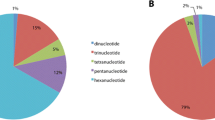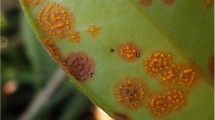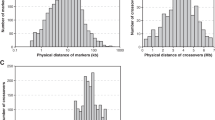Abstract
The genetic structure of two related yeast species, one sexual and one asexual, was compared using polymorphic DNA markers. Although both yeasts propagate by asexual budding of haploid cells, Metschnikowia borealis reproduces sexually when compatible strains come in contact. To what extent this has occurred in nature was not known. As Candida ipomoeae is a closely related, asexual species, the two yeasts provide an excellent model system to assess the role of sexual reproduction in a biogeographic context. Natural isolates of the two species were characterized using several polymorphic DNA markers. As predicted for an organism whose reproduction is strictly clonal, C. ipomoeae exhibited low haplotype diversity, high linkage disequilibrium, and high population differentiation. In contrast, M. borealis had unique haplotypes in most isolates, lower population differentiation, and little linkage disequilibrium, demonstrating that sexual recombination is prevalent. Geographic gradients were identified in both species, indicating that historical and climatic factors both play a role in shaping the populations. The spatial structure is also thought to be influenced by the ecology of the small floricolous beetles (family Nitidulidae) that vector the yeasts. For example, Hawaiian strains of C. ipomoeae show evidence of having undergone a genetic bottleneck, most likely when the vector was introduced to the islands. The two haplotypes found in Hawaii were nearly identical and were also found in North and Central America. M. borealis had a more continuous distribution where the genetic markers follow latitudinal and longitudinal gradients.



Similar content being viewed by others
References
Aa E, Townsend JP, Adams RI, Nielsen KM, Taylor JW (2006) Population structure and gene evolution in Saccharomyces cerevisiae. FEMS Yeast Res 6:702–715. doi:10.1111/j.1567-1364.2006.00059.x
Altschul SF, Gish W, Miller W, Myers EW, Lipman DJ (1990) Basic local alignment search tool. J Mol Biol 215:403–410
Bell G (1988) Uniformity and diversity in the evolution of sex. In: Michod RE, Leven BR (eds) The evolution of sex. Sinauer, Sunderland, Massachusetts, pp 126–138
Burt A, Carter DA, White TJ, Taylor JW (1994) DNA sequencing with arbitrary primer pairs. Mol Ecol 3:523–524. doi:10.1111/j.1365-294X.1994.tb00131.x
Clement M, Posada D, Crandall K (2000) TCS: a computer program to estimate gene genealogies. Mol Ecol 9:1657–1660. doi:10.1046/j.1365-294x.2000.01020.x
Fidalgo Jiménez A, Daniel HM, Evrard P, Decock C, Lachance MA (2008) Metschnikowia cubensis sp. nov., a novel yeast species isolated from flowers in Cuba. Int J Syst Evol Microbiol 58:2955–2961. doi:10.1099/ijs.0.2008/001198-0
Gräser Y, Volovsek M, Arrington J, Schönian G, Presber W, Mitchell TG, Vilgalys R (1996) Molecular markers reveal that population structure of the human pathogen Candida albicans exhibits both clonality and recombination. Proc Natl Acad Sci USA 93:12473–12477. doi:10.1073/pnas.93.22.12473
Hillis DM (2007) Asexual evolution: can species exist without sex? Curr Biol 17:R543–R544. doi:10.1016/j.cub.2007.05.015
Hudson RR, Kreitman M, Aguadé M (1987) A test of neutral molecular evolution based on nucleotide data. Genetics 116:153–159
Johnson LJ, Koufopanou V, Goddard MR, Hetherington R, Schäfer SM, Burt A (2004) Population genetics of the wild yeast Saccharomyces paradoxus. Genetics 166:43–52. doi:10.1534/genetics.166.1.43
Koufopanou V, Hughes J, Bell G, Burt A (2006) The spatial scale of genetic differentiation in a model organism: the wild yeast Saccharomyces paradoxus. Phil Trans Royal Soc Lond. Ser B Biol Sci 361:1941–1946
Kuehne HA, Murphy HA, Francis CA, Sniegowski PD (2007) Allopatric divergence, secondary contact, and genetic isolation in wild yeast populations. Curr Biol 17:407–411. doi:10.1016/j.cub.2006.12.047
Kurtzman CP, Robnett CJ (1998) Identification and phylogeny of ascomycetous yeasts from analysis of nuclear large subunit (26S) ribosomal DNA partial sequences. Antonie Van Leeuwenhoek 73:331–371. doi:10.1023/A:1001761008817
Lachance MA, Rosa CA, Starmer WT, Schlag-Edler B, Barker JSF, Bowles JM (1998a) Metschnikowia continentalis var. continentalis, Metschnikowia continentalis var. borealis, and Metschnikowia hibisci, new heterothallic haploid yeasts from ephemeral flowers and associated insects. Can J Microbiol 44:279–288. doi:10.1139/cjm-44-3-279
Lachance MA, Rosa CA, Starmer WT, Bowles JM (1998b) Candida ipomoeae, a new yeast species related to large-spored Metschnikowia species. Can J Microbiol 44:718–722. doi:10.1139/cjm-44-8-718
Lachance MA, Starmer WT, Bowles JM, Phaff HJ, Rosa CA (2000) Ribosomal DNA, species structure, and biogeography of the cactophilic yeast Clavispora opuntiae. Can J Microbiol 46:195–210. doi:10.1139/cjm-46-3-195
Lachance MA, Bowles JM, Kwon S, Marinoni G, Starmer WT, Janzen DH (2001a) Metschnikowia lochheadii and Metschnikowia drosophilae, two new yeast species isolated from insects associated with flowers. Can J Microbiol 47:103–109. doi:10.1139/cjm-47-2-103
Lachance MA, Starmer WT, Rosa CA, Bowles JM, Barker JSF, Janzen DH (2001b) Biogeography of the yeasts of ephemeral flowers and their insects. FEMS Yeast Res 1:1–8
Lachance MA, Bowles JM, Starmer WT (2003) Metschnikowia santaceciliae, Candida hawaiiana, and Candida kipukae, three new yeast species associated with insects of tropical morning glory. FEMS Yeast Res 3:97–103
Lachance MA, Ewing CP, Bowles JM, Starmer WT (2005) Metschnikowia hamakuensis sp. nov., Metschnikowia kamakouana sp. nov., and Metschnikowia mauinuiana sp. nov., three endemic yeasts from Hawaiian nitidulid beetles. Int J Syst Evol Microbiol 55:1369–1377. doi:10.1099/ijs.0.63615-0
Lachance MA, Lawrie D, Dobson J, Piggott J (2008) Biogeography and population structure of the Neotropical endemic yeast species Metschnikowia lochheadii. Antonie Van Leeuwenhoek 94:403–414. doi:10.1007/s10482-008-9258-7
Lomolino MV, Riddle BR, Brown JH (2006) Biogeography, 3rd edn. Sinauer Associates, Sunderland, Massachuetts, 752 pp
Mantel N (1967) The detection of disease clustering and a generalized regression approach. Cancer Res 27:209–220
Marinoni G, Lachance MA (2004) Speciation in the large-spored Metschnikowia clade and establishment of a new species, Metschnikowia borealis comb. nov. FEMS Yeast Res 4:587–596. doi:10.1016/j.femsyr.2003.12.005
Marinoni G, Piskur J, Lachance MA (2003) Ascospores of large-spored Metschnikowia species are genuine meiotic products of these yeasts. FEMS Yeast Res 3:85–90
Maynard Smith J, Smith NH, O’Rourke M, Spratt B (1993) How clonal are bacteria? Proc Natl Acad Sci USA 90:4384–4388. doi:10.1073/pnas.90.10.4384
McNeill J et al (2006) International Code of Botanical Nomenclature (Vienna Code). Fantner Verlag, Ruggell, p 568
Nasir H, Noda H (2003) Yeast-like symbiotes as a sterol source in anobiid beetles (Coleoptera, Anobiidae): possible metabolic pathways from fungal sterols to 7-dehydrocholesterol. Arch Insect Biochem Physiol 52:175–182. doi:10.1002/arch.10079
Nishida T (1957) Food plants, distribution, and variation in abundance of Conotelus mexicanus Murray, a recently discovered immigrant insect in Hawaii (Coleoptera: Nitidulidae). Proc Hawaii Entomol Soc 16:307–312
Raymond M, Rousset F (1995) GENEPOP (version 1.2): population genetics software for exact tests and ecumenicism. J Hered 86:248–249
Replansky T, Koufopanou V, Greig D, Bell G (2008) Saccharomyces sensu stricto as a model system for evolution and ecology. Trends Ecol Evol 23:494–501. doi:10.1016/j.tree.2008.05.005
Rosa CA, Lachance MA, Teixeira LCRS, Pimenta RS, Morais PB (2007) Metschnikowia cerradonensis sp. nov., a yeast species isolated from ephemeral flowers and their nitidulid beetles in Brazil. Int J Syst Evol Microbiol 57:161–165. doi:10.1099/ijs.0.64624-0
Rozas J, Sanchez-Delbarrio JC, Messeguer X, Rozas R (2003) DnaSP, DNA polymorphism analyses by the coalescent and other methods. Bioinformatics 19:2496–2497. doi:10.1093/bioinformatics/btg359
Sampaio JP, Gonçalves P (2008) Natural populations of Saccharomyces kudriavzevii in Portugal are associated with oak bark and are sympatric with S. cerevisiae and S. paradoxus. Appl Environ Microbiol 74:2144–2152. doi:10.1128/AEM.02396-07
Sniegowski PD, Dombrowski PG, Fingerman E (2002) Saccharomyces cerevisiae and Saccharomyces paradoxus coexist in a natural woodland site in North America and display different levels of reproductive isolation from European conspecifics. FEMS Yeast Res 1:299–306
Templeton AR, Crandall KA, Sing CF (1992) A cladistic analysis of phenotypic associations with haplotypes inferred from restriction endonuclease mapping and DNA sequence data. III. Cladogram estimation. Genetics 132:619–633
Tsai IJ, Bensasson D, Burt A, Koufopanou V (2008) Population genomics of the wild yeast Saccharomyces paradoxus: quantifying the life cycle. Proc Natl Acad Sci USA 105:4957–4962. doi:10.1073/pnas.0707314105
Weaver SE, Riley WR (1982) The biology of Canadian weeds. 53. Convoluvulus arvensis. Can J Plant Sci 62:461–472
Williams RN, Jelínek J, Habeck DH (1988) Annotated bibliography of the genus Conotelus Erichson (Coleoptera: Nitidulidae). Miscell Publ Entomol Soc Am 69:1–14
Xu J (2004) The prevalence and evolution of sex in microorganisms. Genome 47:775–780. doi:10.1139/g04-037
Yarrow D (1998) Methods for the isolation and identification of yeasts. In: Kurtzman CP, Fell JW (eds) The yeasts, a taxonomic study, vol 4. Elsevier, Amsterdam, pp 77–100
Zeyl C (2007) Ploidy and the sexual yeast genome in theory, nature, and experiment. In: Hietman J, Kronstad JW, Taylor JW, Casselton LA (eds) Sex in Fungi. Molecular determination, evolutionary implications. ASM Press, Washington, pp 507–525
Acknowledgments
We acknowledge funding from the Natural Science and Engineering Research Council (Discovery Grant to MAL, USRA Scholarships to AMW and KCM). We also acknowledge the Costa Rican Ministry of the Environment and the US National Park Service for the issuance of collection or research permits. Assistance with field collections by Jane Bowles, Felipe Chavaria, Dan Janzen, Louise Lachance, Marcel Legault, Michal Polak, Carlos Rosa, and Tom Starmer is greatly appreciated. We thank Julie Collens and an anonymous reviewer for very helpful suggestions.
Author information
Authors and Affiliations
Corresponding author
Rights and permissions
About this article
Cite this article
Wardlaw, A.M., Berkers, T.E., Man, K.C. et al. Population structure of two beetle-associated yeasts: comparison of a New World asexual and an endemic Nearctic sexual species in the Metschnikowia clade. Antonie van Leeuwenhoek 96, 1–15 (2009). https://doi.org/10.1007/s10482-009-9330-y
Received:
Accepted:
Published:
Issue Date:
DOI: https://doi.org/10.1007/s10482-009-9330-y




